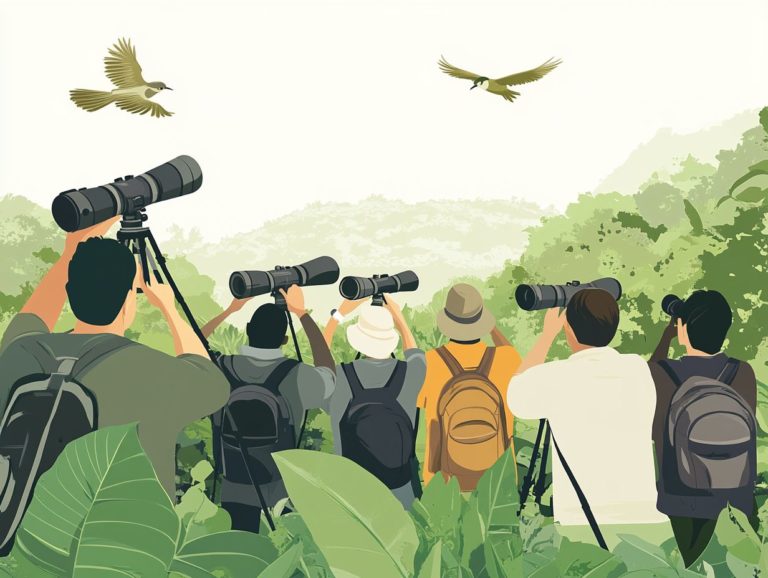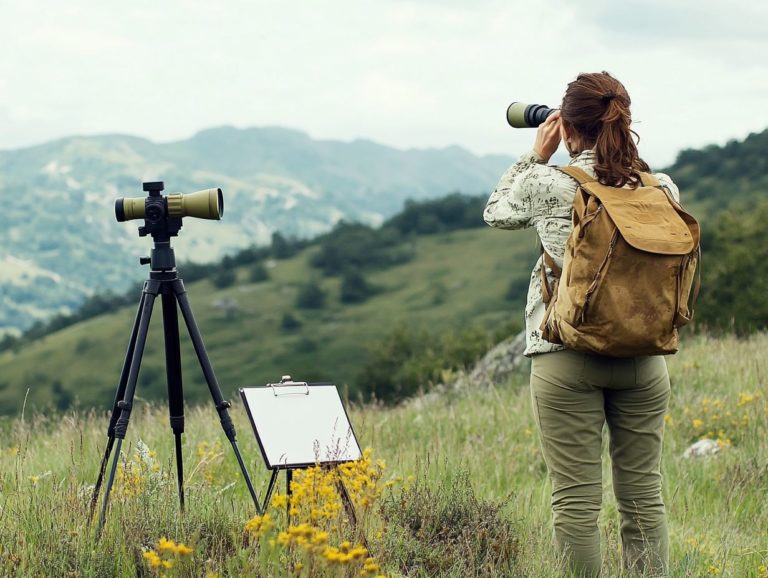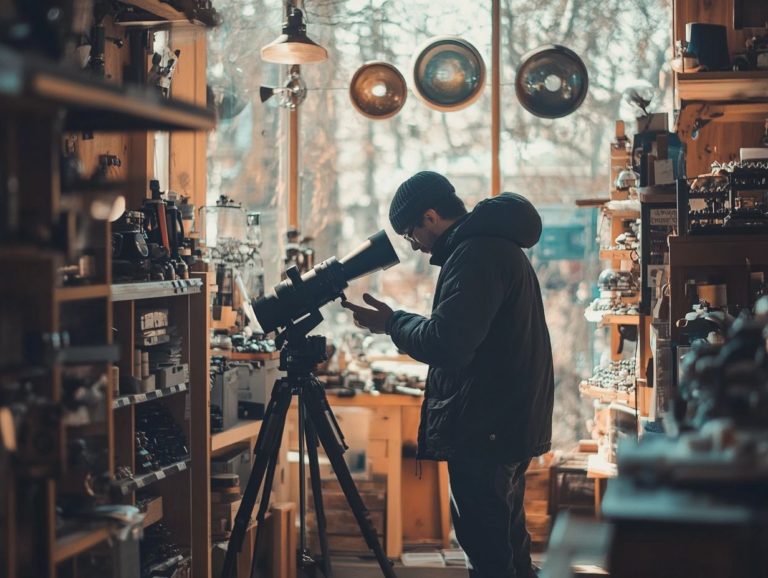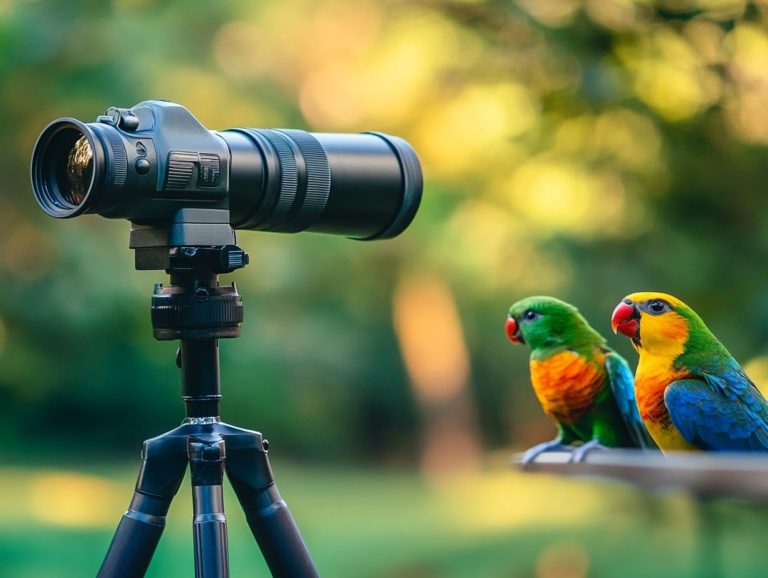Top Features to Look for in a Spotting Scope
Choosing a spotting scope is an art, and understanding key features like magnification range can elevate your outdoor experience to new heights.
From magnification power to durability, every detail enhances the value of your investment. Whether you re birdwatching, hunting, or stargazing, knowing what to prioritize empowers you to make an informed decision.
Explore the essential features you should consider. This will simplify your quest for the perfect spotting scope and ensure you enjoy every moment in nature.
- Key Takeaways:
- 1. Magnification Power
- 2. Objective Lens Size
- 3. Prism Type
- 4. Lens Coating
- 5. Field of View
- 6. Eye Relief
- 7. Close Focus
- 8. Waterproof and Fogproof
- 9. Durability
- 10. Weight and Size
- 11. Accessories Included
- 12. Price Range
- 13. Brand Reputation
- 14. Warranty
- 15. Customer Reviews
- Frequently Asked Questions
- What are the top features to look for in a spotting scope?
- What is the ideal magnification power for a spotting scope?
- How does the objective lens size affect the performance of a spotting scope?
- What are lens coatings, and why are they important in a spotting scope?
- How can I ensure the durability of a spotting scope?
- Is portability an important factor to consider when choosing a spotting scope?
- Opt for a spotting scope with high magnification for a closer, clearer view.
- Choose a larger objective lens for brighter images, especially in low light.
- Select a high-quality prism type for better light transmission and clarity.
Contents
Key Takeaways:
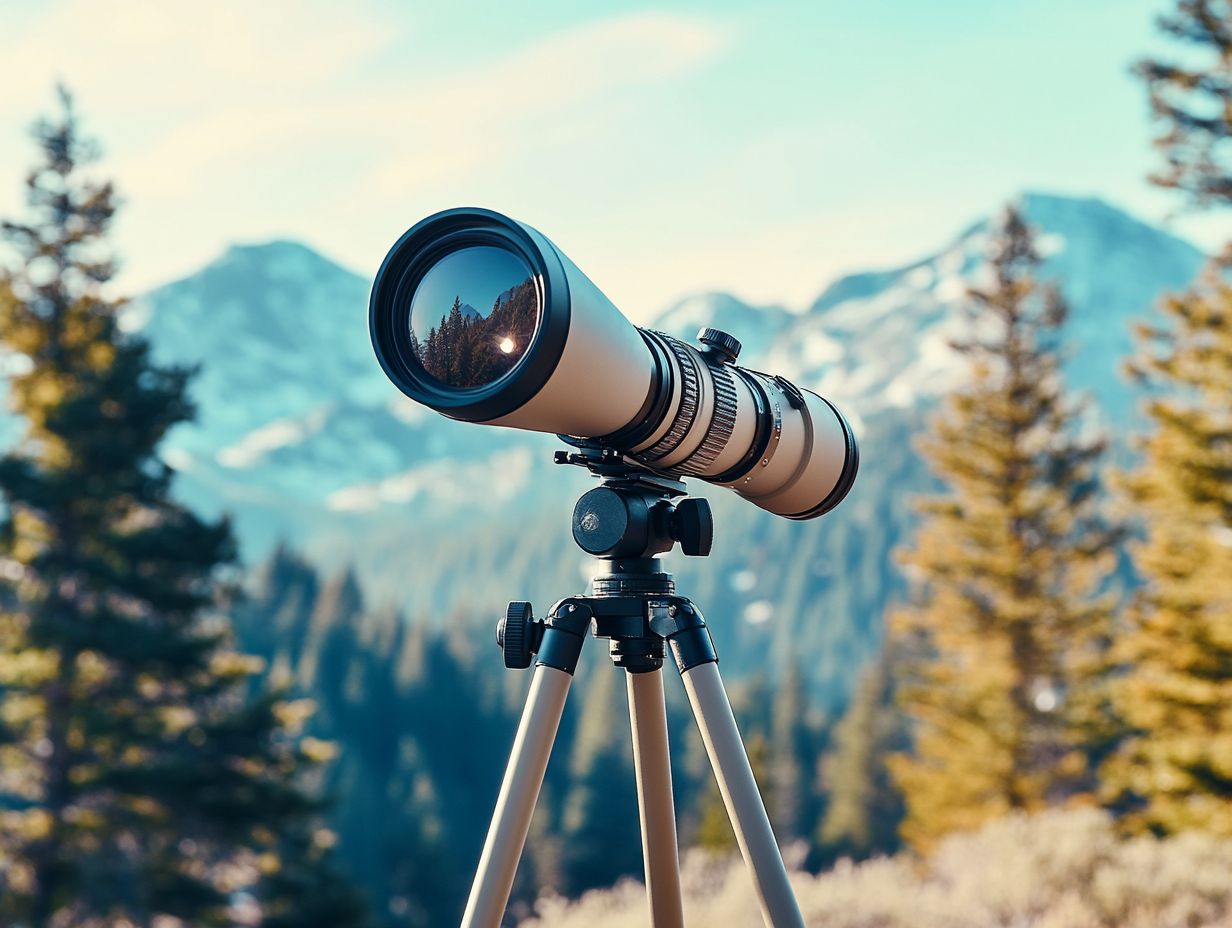
1. Magnification Power
Magnification power plays a pivotal role in the effectiveness of spotting scopes. It significantly impacts your ability to observe distant wildlife or scenic vistas with remarkable clarity.
This factor is essential for activities such as birding and wildlife viewing. By grasping the magnification range from 50mm to 85mm you can choose the perfect scope tailored to various environments. Whether you’re exploring the Great Smoky Mountains or the expansive plains of South Africa, encounters with animals like Kudu and Eland are commonplace.
Different levels of magnification can profoundly transform your viewing experience. Higher magnifications may reveal intricate details of a bird’s plumage, but they can also reduce brightness in low-light conditions.
For example, consider Vortex’s Viper HD 20-60×85 model, which excels in delivering exceptional clarity at high power. In contrast, Meopta s MeoStar S2 80 HD strikes an impressive balance between brightness and detail, appealing to wildlife enthusiasts. This distinction in performance makes Vortex a top choice for those seeking versatility, while Meopta caters to individuals who prioritize light transmission.
Understanding these features ensures you make the best choice for your adventures!
2. Objective Lens Size
The size of the objective lens in your spotting scope is crucial for light transmission and overall optical quality. This makes it a key consideration if you seek high performance in various lighting conditions.
A larger objective lens significantly boosts your ability to gather light. This is especially vital in low-light situations, like early morning or dusk when wildlife is most active. This feature is a game-changer for outdoor lovers!
Brands such as Vortex and Nikon have crafted their scopes to maximize clarity and brilliance in these challenging environments. In wildlife viewing and digiscoping capturing photos through your spotting scope with a camera the differences become even more striking.
A premium lens can capture intricate details and vibrant colors that might otherwise slip through the cracks. Thus, investing in a high-quality optical system not only enhances your experience but ensures that every sighting feels vivid and true-to-life.
3. Prism Type
The type of prism in your spotting scope whether it’s a roof or Porro plays a crucial role in determining its optical quality. This in turn affects the clarity and brightness of the images you capture during your observations.
Roof prisms are celebrated for their compact design, allowing for a sleeker, more portable spotting scope. This makes them a favorite among birdwatchers and outdoor enthusiasts who prioritize mobility in the field.
On the other hand, Porro prisms offer a more traditional optical layout, providing a wider field of view, though they tend to be bulkier. Your choice between these two options can significantly influence the weight of your equipment and your overall viewing comfort.
Investing in advanced materials like Extra-low Dispersion (ED) glass and High Definition (HD) lenses can elevate your experience even further. These enhancements reduce chromatic aberration and improve color fidelity, leading to sharper images and better clarity under varying lighting conditions.
4. Lens Coating
Lens coatings are essential in spotting scopes. When you opt for fully multi-coated optics, you enhance light transmission and image brightness. This ensures optimal performance in various viewing conditions, even in fog.
These advanced coatings minimize reflection and maximize the light that passes through the lens system. This directly affects the clarity and sharpness of the images you observe. They allow more light to reach your eyepiece and help reduce glare, making it easier to spot details without straining your eyes.
For fogproof spotting scopes, these coatings are even more beneficial. They maintain image quality in humid or damp conditions by preventing moisture from interfering with your visuals, allowing for a crisp and clear view, no matter the weather.
5. Field of View
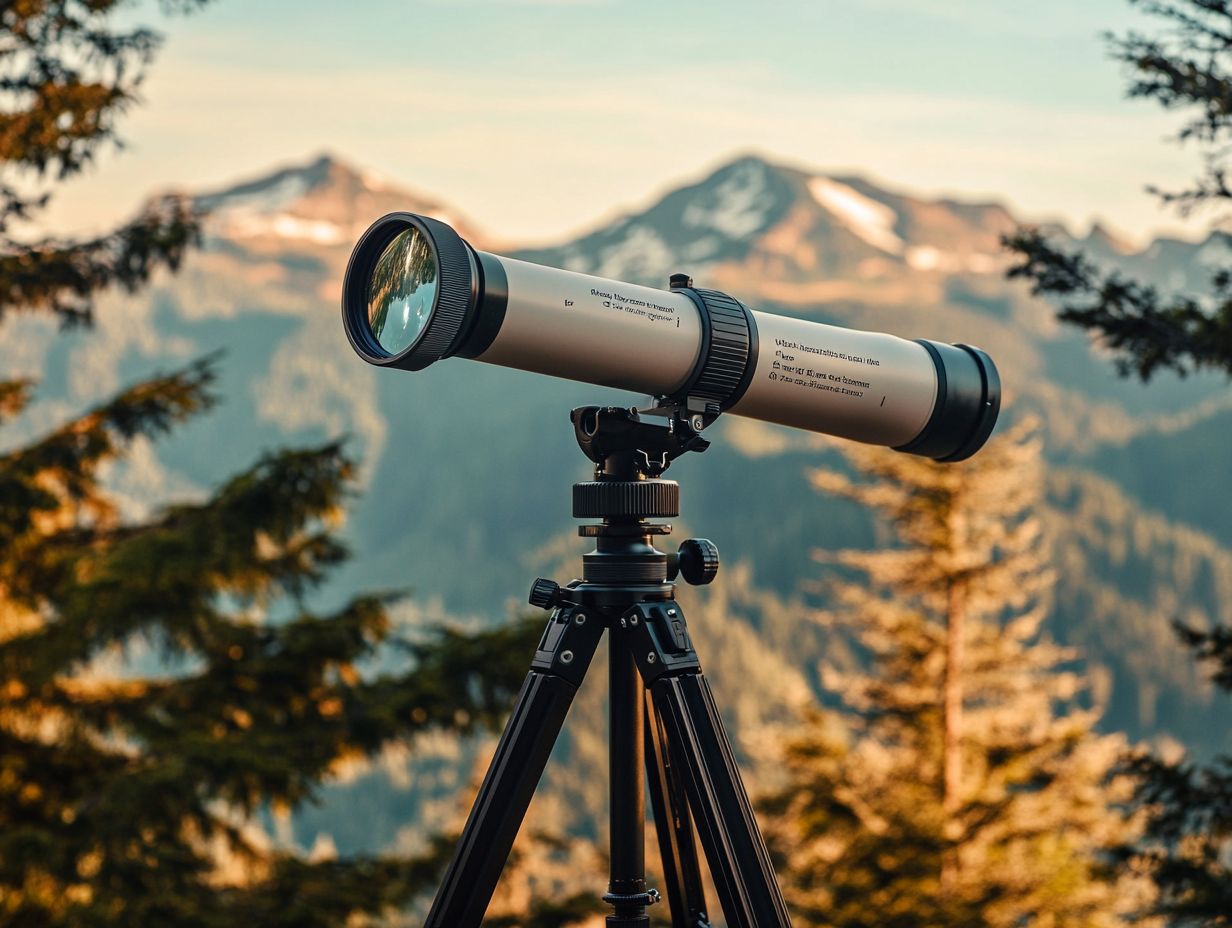
Field of view is a crucial specification in spotting scopes, especially with high magnification models. It decides how much of the scene you can see at once, significantly affecting your wildlife viewing experience.
This measurement is usually expressed in feet or meters at a distance of 1,000 yards or meters. It reveals the width of the observable area. As a birdwatcher, a wider field of view allows for easier tracking of fast-moving subjects, like birds in flight.
However, there’s a trade-off between magnification and field of view. Increasing magnification can narrow your field. For example, a spotting scope offering 20x magnification may provide a narrower field than a 10x model.
Some models, like the Vortex Diamondback, excel in balancing both features effectively. This makes them ideal for those who are passionate about bird watching.
6. Eye Relief
Eye relief is a crucial aspect of spotting scopes. It determines the distance from the eyepiece at which you can comfortably observe the image without straining your eyes. This feature makes every moment spent watching wildlife truly exciting!
For those who wear glasses, the significance of adequate eye relief is critical. It allows you to avoid the discomfort of removing your eyewear just to see through the scope. A generous eye relief, typically exceeding 15mm, ensures that you can enjoy long viewing sessions without fatigue.
Take the Vortex Optics Viper HD, which boasts up to 17mm of eye relief. This makes it a fantastic option for glasses wearers. Similarly, the Leupold SX-2 Kenai 2 offers an impressive 20mm of eye relief, providing a more relaxed and unobstructed field of view, making it ideal for birding scopes.
7. Close Focus
Close focus capability is an invaluable feature in spotting scopes, especially for birding enthusiasts. It allows for detailed observation of subjects at close range, enriching your wildlife watching experience.
With this capability, you can appreciate intricate details think feather patterns and the unique behaviors of small creatures that would otherwise slip by unnoticed at greater distances. Models such as the Vortex Razor HD and the Zeiss Conquest Gavia shine in this regard, enabling you to observe subjects as close as 10 to 15 feet away.
By minimizing the distance for effective spotting, these scopes elevate your overall viewing experience, making each encounter with nature deeply immersive and rewarding.
8. Waterproof and Fogproof
A waterproof and fogproof design is absolutely essential in a high-quality spotting scope. This ensures reliability and durability in challenging weather conditions, which is crucial for avid birders and wildlife watchers like yourself. To learn more, check out our guide on understanding the technology behind spotting scopes.
These features not only shield the internal components from moisture but also effectively prevent fogging in humid environments or during sudden temperature shifts. When your spotting scope faces rain or more extreme elements, these characteristics become pivotal for maintaining optimal visibility.
Renowned brands like Vortex and Leica excel in crafting rugged designs that integrate robust seals and nitrogen purging which prevents fogging by filling the scope with nitrogen gas giving you peace of mind as an outdoor enthusiast.
By investing in a spotting scope equipped with these capabilities, you’re ensuring enhanced longevity and trusted performance. If you’re considering a more budget-friendly option, be sure to check out what to consider when buying a used spotting scope. This allows you to focus on your observations without the nagging worry of your equipment faltering due to environmental challenges.
9. Durability
Think of durability as your best friend for outdoor adventures! It should be at the forefront of your mind when selecting a spotting scope, especially for wildlife viewing across various terrains.
Opt for spotting scopes made from high-quality, shock-resistant materials like aluminum or polycarbonate; these provide exceptional protection against drops and impacts. A sturdy rubber armor casing not only enhances your grip but also protects the optics from moisture and dust.
If the design features nitrogen-purged interiors and fully multi-coated lenses, you’re looking at a significant boost in longevity and clarity essential for those extended outdoor excursions.
The impact of this durability is considerable; it not only prolongs the lifespan of your equipment but also elevates your overall experience by ensuring reliable performance in tough conditions.
Ultimately, investing in such quality represents a smart choice for passionate outdoor enthusiasts who appreciate the benefits of top-tier brands like Leupold and Swarovski.
10. Weight and Size
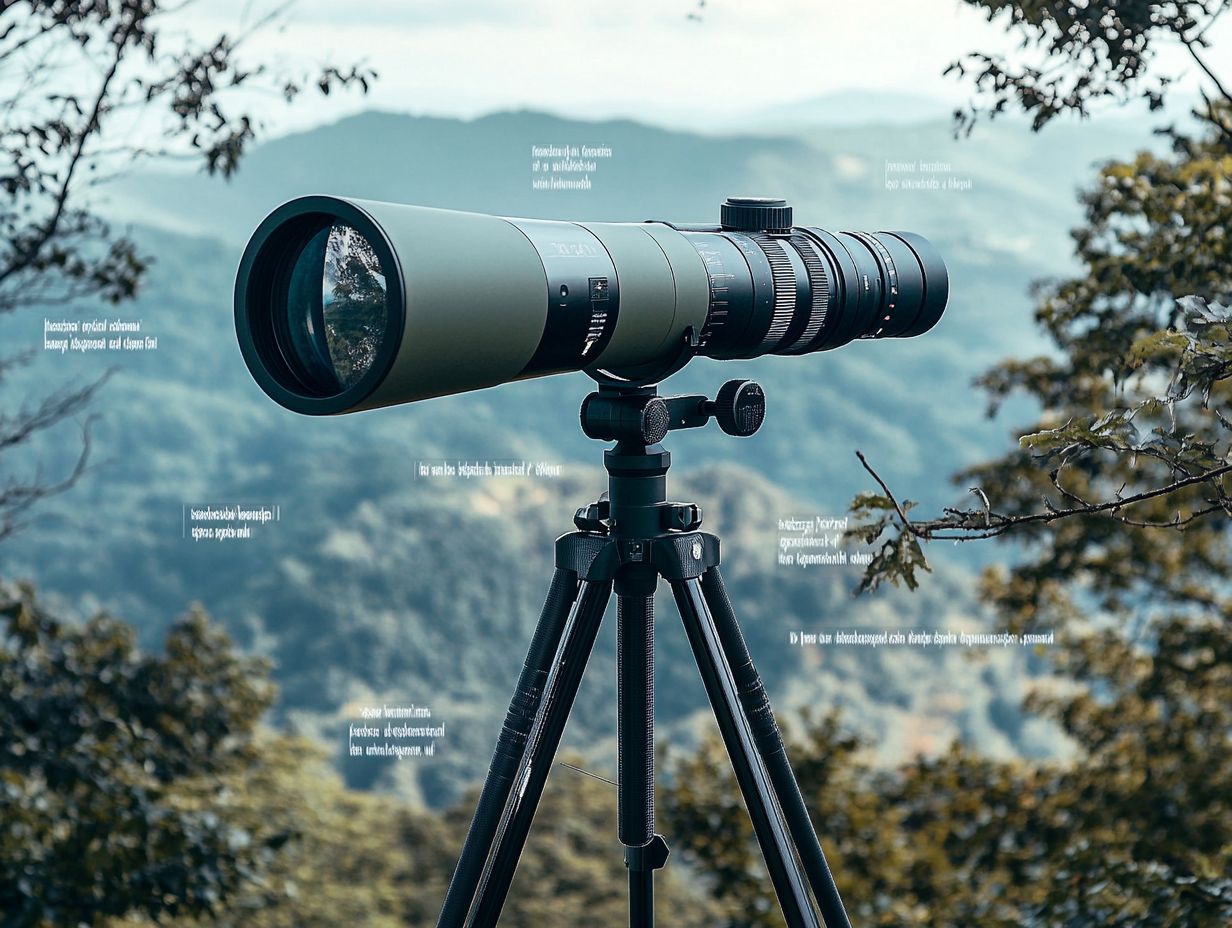
The weight and size of a spotting scope are key factors that influence its portability and ease of use in the field, making them essential considerations for those who frequently travel for wildlife watching or birding.
When selecting a model, carefully weigh the balance between magnification and weight. Heavier scopes might offer superior optics, but they can quickly become burdensome on long hikes.
If you re a casual birder who enjoys short trips, a lightweight option with compact dimensions could significantly enhance your experience. Consider the SX-2 Alpine HD for its balance of weight and performance.
On the other hand, if you re a serious birdwatcher planning extended excursions, you might prioritize a model with exceptional zoom capabilities, accepting a bit more weight in exchange for quality, such as the SX-4 Pro Guide HD for its impressive features.
Understanding how these dimensions interact with your specific outdoor activities can help you choose the ideal scope that aligns with your adventurous spirit, whether you re trekking through rugged terrain or simply savoring a tranquil day in the park.
Choose wisely now to make your next adventure unforgettable!
11. Accessories Included
The accessories that come with your spotting scope, like a tripod mount, can significantly enhance its usability and expand its functionality, especially if you re a digiscoping enthusiast.
By incorporating a sturdy tripod, you not only stabilize your viewing but also enable yourself to observe for extended periods without feeling fatigued. A reliable carrying case will keep your equipment safe during all your outdoor adventures.
If you re keen on capturing images, investing in high-quality digiscoping gear can elevate your experience tremendously, allowing you to snap breathtaking photos through the scope. Brands like Nikon offer exceptional options for this purpose.
Brands like Vortex and Celestron offer comprehensive accessory packages that cater to everyone, from beginners to seasoned users, including the popular Gold Ring HD making it easier for you to enhance your spotting scope setup and ensure you have everything you need for a truly fulfilling observational experience.
12. Price Range
Understanding the price range of spotting scopes is crucial for you as a consumer. It helps you identify options that fit your budget while ensuring you get high-quality lenses, like those found in the Leupold and Swarovski brands.
Evaluating different price points reveals that lower-end models offer basic functionality but often lack the clarity and brightness that avid users expect. Mid-range options usually enhance optical quality and build durability, making them solid choices for enthusiasts.
In contrast, high-end scopes provide exceptional lenses and robust mechanisms, allowing fine-tuning that significantly enhances your viewing experience. It’s essential to balance your spending with the quality of the optics.
Investing in a superior lens, especially from top brands like Nikon or Celestron, can dramatically elevate your satisfaction and performance in the field. Don t miss out on the best lenses invest wisely today!
13. Brand Reputation
Brand reputation greatly influences your choice when selecting a spotting scope. Well-known manufacturers like Leupold, Swarovski, and Celestron are associated with quality and performance in the optics industry. This association builds your confidence as a consumer.
You’re likely to trust products from brands with a strong market presence, such as Vortex, reflecting their commitment to excellence. The craftsmanship and technological innovation from these companies enhance your user experience and ensure reliable performance.
Take flagship models like the Swarovski ATX, celebrated for its exceptional clarity and versatility. On the other hand, Leupold s SX-4 Pro Guide HD boasts durable construction, perfectly tailored for demanding outdoor conditions.
These products illustrate how a stellar brand reputation aligns with superior quality, ultimately elevating customer satisfaction. For example, the SX-2 Alpine HD has received positive reviews for its performance.
14. Warranty
A great warranty is essential for peace of mind! It showcases the manufacturer s confidence in the reliability of their product and provides you with much-needed reassurance.
Brands like Celestron often offer detailed warranties to support their high-quality products. Different brands provide various warranty options, from limited warranties covering specific defects to more comprehensive plans that include accidental damage.
These warranties typically cover essential components, ensuring your equipment remains reliable over time, especially for high-end models like Swarovski.
The impact on customer satisfaction is substantial; feeling secure in your investment deepens your loyalty to the brand. Effective customer support services are also critical in navigating the warranty process, enhancing your experience by making repairs and replacements seamless.
15. Customer Reviews
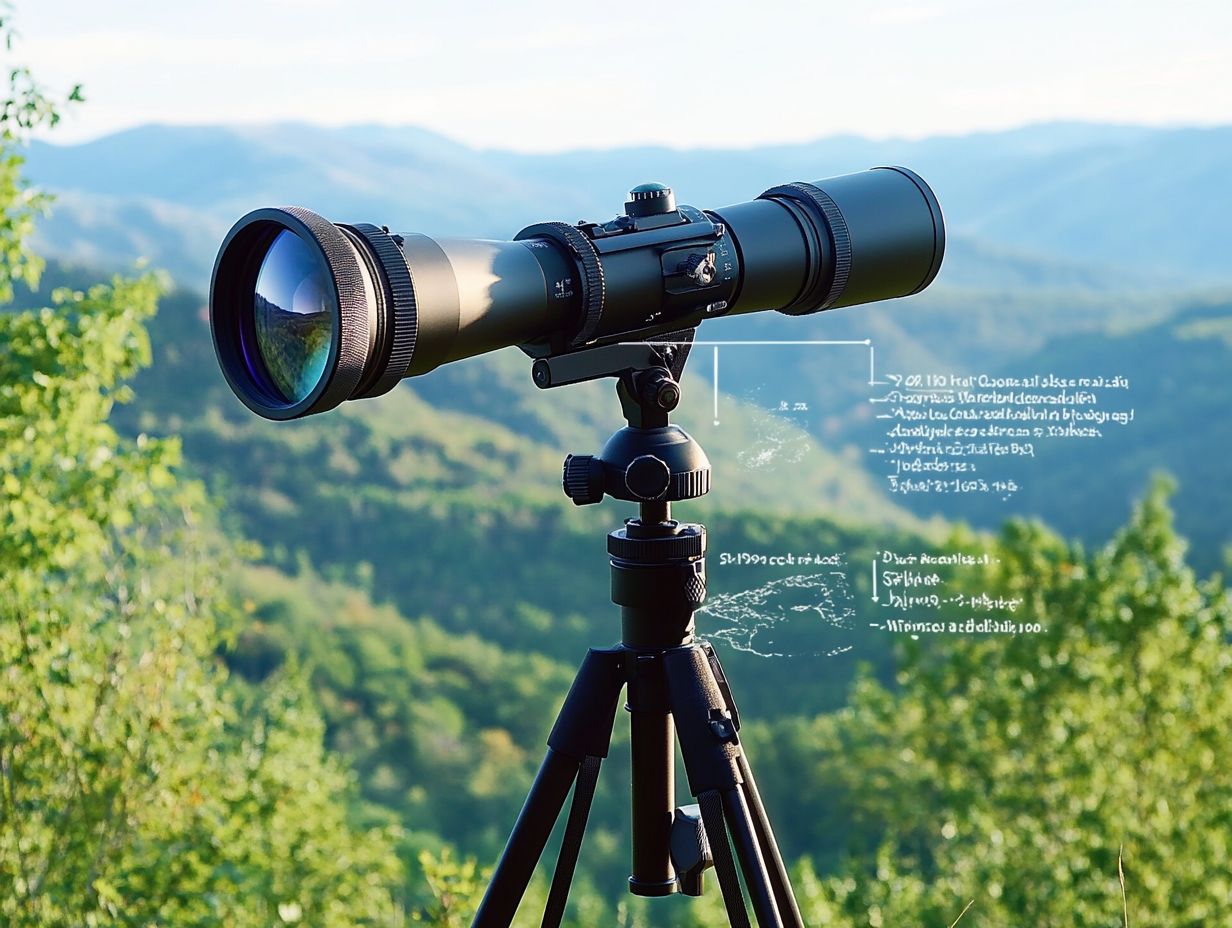
Customer reviews are essential for potential buyers of spotting scopes. They provide insights into user experiences, product quality, and performance.
These reviews act as a trusted guide when evaluating different models. Verified purchasers often highlight durability in adverse weather and clarity of optics.
This feedback helps you make informed choices based on your needs. Whether birdwatching, hunting, or stargazing, these insights are invaluable!
Frequently Asked Questions
What are the top features to look for in a spotting scope?
The top features include magnification power, the front lens size, lens coatings, durability, and portability, all of which are essential to consider when exploring understanding spotting scopes.
What is the ideal magnification power for a spotting scope?
The ideal magnification power depends on your intended use but typically ranges from 15x to 60x. Higher magnification is better for long-range viewing, while lower magnification is ideal for close-range and moving objects.
How does the objective lens size affect the performance of a spotting scope?
The front lens size determines the amount of light entering the scope, affecting the clarity and brightness of the image. A larger lens size is beneficial for low-light conditions and provides a wider field of view.
What are lens coatings, and why are they important in a spotting scope?
Lens coatings are layers applied to the glass to reduce glare, improve light transmission, and enhance image quality. They help reduce eye strain and produce clear images even in challenging lighting conditions.
How can I ensure the durability of a spotting scope?
To ensure durability, look for a scope with rugged, waterproof construction made from high-quality materials such as magnesium or aluminum. A protective coating is also important to prevent scratches and damage from outdoor elements.
Is portability an important factor to consider when choosing a spotting scope?
Yes, portability is crucial for outdoor activities like hunting or birdwatching. Look for a lightweight, compact design, and features like a carrying case or tripod mount for easy transportation.
Ready to choose your perfect spotting scope? Dive into those reviews and make your next outdoor adventure unforgettable!

